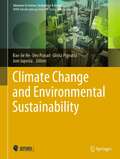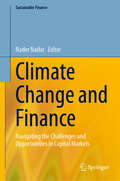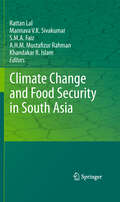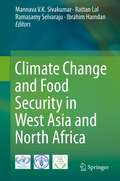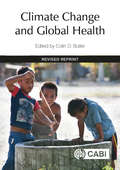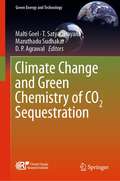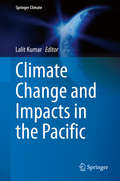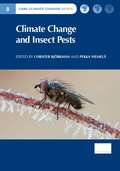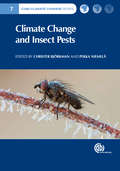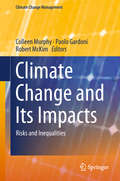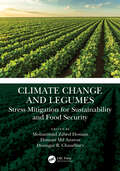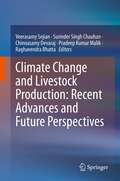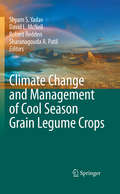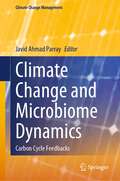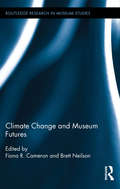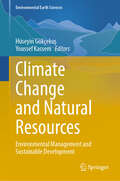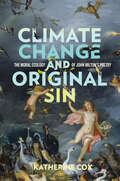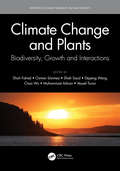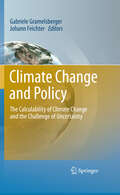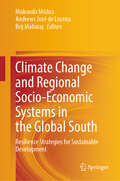- Table View
- List View
Climate Change and Environmental Sustainability (Advances in Science, Technology & Innovation)
by Joni Jupesta Deo Prasad Bao-Jie He Gloria PignattaThis book discusses the challenges related to climate change mitigation and adaptation. It adds valuable strategies and insights into the development of new practices solving the identified social and economic problems related to ecosystem deterioration and anticipating other disasters related to climate change. As the decarbonization of cities and communities became an issue of great interest to many researchers, the book in hands will be of great importance to decision-makers and energy stakeholders and others seeking a more resilient and sustainable future and developing innovative technologies to overcome environmental deterioration.This book is a culmination of selected research papers from the first version of the international conference on ‘Climate Chance and Environmental Sustainability’ which was held in 2021 in collaboration with Chongqing University, China.
Climate Change and Estuaries (CRC Marine Science)
by Michael J. Kennish, Hans W. Paerl, and Joseph R. CrosswellClimate change is having an increasing impact on coastal, estuarine, and marine environments worldwide. This book provides state-of-the-art coverage of climate change effects on estuarine ecosystems from local, regional, and global perspectives. With editors among the most noted international scholars in coastal ecology and estuarine science and contributors who are world-class in their fields, the chapters in this volume consist of comprehensive studies in coastal, estuarine and marine sciences, climate change, and coastal management and provide an extensive international collection of data in tabular, illustrated, and narrative formats useful for coastal scientists, planners, and managers. Comprised of three sections: (1) physical-chemical aspects; (2) biological aspects; and (3) management aspects, the book not only examines climatic and non-climatic drivers of change affecting coastal, estuarine, and marine environments but also their interactions and effects on populations of organisms, communities, habitats, and ecosystem structure and function. Pulling together today’s most salient issues and key literature advances for those concerned with coastal management, it allows the reader to see across direct and indirect interactions among disciplinary and ecosystem boundaries. Climate Change and Estuaries meets the research needs of climate scientists, estuarine and marine biologists, marine chemists, marine geologists, hydrologists, and coastal engineers, while students, professors, administrators, and other professionals will also find it an exhaustive reference.
Climate Change and Finance: Navigating the Challenges and Opportunities in Capital Markets (Sustainable Finance)
by Nader NaifarFinancial markets play a critical role in climate finance as they are a major source of funding for many of the projects and initiatives aimed at addressing climate change. For instance, banks and investors can provide loans and capital to companies that are developing renewable energy projects, building energy-efficient infrastructure, or implementing climate-smart agricultural practices. Moreover, the importance of climate finance in financial markets goes beyond just funding environmental initiatives. Investors and financial institutions are increasingly factoring in climate risks and opportunities into their decision-making processes, including assessing the financial risks posed by climate change and the potential impact of new regulations and policies aimed at reducing greenhouse gas emissions.This book is a collection of recent developments in climate change and climate finance. As the global community seeks to address the impacts of climate change, financial institutions are being called upon to play a larger role in supporting the transition to a sustainable economy. This includes incorporating climate risks into investment decisions, developing new financial products that support climate-friendly investments, and promoting greater transparency and accountability in the financial sector. The book provides a comprehensive analysis of how climate change is impacting the global financial system and explores the potential solutions that can help address these challenges. The contributions aim to examine the complex interplay between climate change and finance, and the potential for innovative financial instruments and policies to support the transition to a low-carbon economy.
Climate Change and Food Security in South Asia
by Rattan Lal A.H.M. Mustafizur Rahman Khandakar R. Islam Mannava Vk Sivakumar S.M.A. FaizThis book addresses an important topic of food security in South Asia with specific reference to climate change. Of the 1 billion food insecure people in the world, more than 30% are in South Asia. The problem of food insecurity may be exacerbated by the projected climate change especially because of the water scarcity caused by rapid melting of the glaciers in the Himalayas and increase in variability in monsoonal rains and frequency of extreme events. Furthermore, large populations of Bangladesh and other coastal regions may be displaced by sea level rise. Thus, this volume addresses recommended land use and soil/water/crop/vegetation management practices which would enable land managers to adapt to climate disruption by enhancing soil/ecosystem/social resilience. In addition to biophysical factors, this book also addresses the issues related to human dimensions including social, ethnical and political considerations.
Climate Change and Food Security in West Asia and North Africa
by Rattan Lal Mannava Sivakumar Ibrahim Hamdan Ramasamy SelvarajuThe countries of West Asia and North Africa (WANA) have long had the challenge of providing sustainable livelihoods for their populations in the fragile ecosystems of semi-arid and arid areas. Climate change is already a reality in WANA and it places additional constraints on the already fragile ecosystems of dry areas and limited natural resources in WANA. A comprehensive and integrated approach to planning and implementing the climate change adaptation strategies across the wide range of agro-ecosystems in different countries in WANA could help both the planners and the local communities to deal effectively with the projected impacts and also contribute to overall sustainability of agricultural production systems. This book addresses the important issue of climate change and food security in West Asia and North Africa and presents the appropriate strategies which could help in the development of new policies to better adapt agriculture production systems and enhance food security in WANA.
Climate Change and Food Security: Adapting Agriculture to a Warmer World (Advances in Global Change Research #37)
by David B. Lobell Marshall BurkeRoughly a billion people around the world continue to live in state of chronic hunger and food insecurity. Unfortunately, efforts to improve their livelihoods must now unfold in the context of a rapidly changing climate, in which warming temperatures and changing rainfall regimes could threaten the basic productivity of the agricultural systems on which most of the world's poor directly depend. But whether climate change represents a minor impediment or an existential threat to development is an area of substantial controversy, with different conclusions wrought from different methodologies and based on different data. This book aims to resolve some of the controversy by exploring and comparing the different methodologies and data that scientists use to understand climate's effects on food security. In explains the nature of the climate threat, the ways in which crops and farmers might respond, and the potential role for public and private investment to help agriculture adapt to a warmer world. This broader understanding should prove useful to both scientists charged with quantifying climate threats, and policy-makers responsible for crucial decisions about how to respond. The book is especially suitable as a companion to an interdisciplinary undergraduate or graduate level class.
Climate Change and Global Health
by Colin ButlerThere is increasing understanding, globally, that climate change will have profound and mostly harmful effects on human health. This authoritative book brings together international experts to describe both direct (such as heat waves) and indirect (such as vector-borne disease incidence) impacts of climate change, set in a broad, international, economic, political and environmental context. This unique book also expands on these issues to address a third category of potential longer-term impacts on global health: famine, population dislocation, and conflict. This lively yet scholarly resource explores these issues fully, linking them to health in urban and rural settings in developed and developing countries. The book finishes with a practical discussion of action that health professionals can yet take. Now with added chapter updating key changes affecting climate change and health through 2015, culminating with UN secretary general Ban Ki Moon's hopeful comment "What was once unthinkable is now unstoppable". Climate change, now clearly worsening, is triggering a powerful social and technological response. Will this response be sufficient to avert its potentially catastrophic "tertiary" health effects? Read a chapter for free.
Climate Change and Green Chemistry of CO2 Sequestration (Green Energy and Technology)
by T. Satyanarayana Malti Goel Maruthadu Sudhakar D. P. AgrawalThe book comprises state-of-the-art scientific reviews on carbon management strategies in response to climate change. It provides in-depth information on topics relating to recent advances in carbon capture technology and its reuse in value added products. It features contributions of leading scientists and technocrats on topics including climate change and carbon sequestration, lowering carbon footprint CO2 capture, low carbon imperatives in oil industry, CO2 as refrigerant in cold-chain application, carbonic anhydrase-mediated carbon sequestration and utilization, chemical looping combustion with Indian coal, CO2 conversion to chemicals, algae based biofuels, and carbon capture patent landscaping analysis. The contents of this book will be helpful for research scholars, post-graduate students, industry, agricultural scientists and policy makers/planners.
Climate Change and Human Adaptation in India: Sustainability and Public Policy (Sustainable Development Goals Series)
by Sanjeev Sharma Kaushal Kumar Sharma Vijendra Kumar Pandey Rupendra SinghThis contributed volume presents an attempt to understand climatic variability and induced risk to livelihood of communities and to offer insights on how catastrophic conditions and crises can be mitigated through public policy interventions. The case studies herein offer insights into different spheres and domains affected by climate change and present models of adaptation possibilities. The book is divided into three thematic sections. The first contains chapters that deal with assessing the effects of climate change. The second section offers perspectives on adaptation and governance, vulnerability in the context of sustainable livelihoods. The third and last section looks at Policy and Governance, with respect to climatic change adaptation and mitigations. The lessons contained in this volume are useful to a wide audience including research scholars, students, policymakers, and planners.
Climate Change and Human Responses: A Zooarchaeological Perspective (Vertebrate Paleobiology and Paleoanthropology)
by Gregory G. MonksThis book contributes to the current discussion on climate change by presenting selected studies on the ways in which past human groups responded to climatic and environmental change. In particular, the chapters show how these responses are seen in the animal remains that people left behind in their occupation sites. Many of these bones represent food remains, so the environments in which these animals lived can be identified and human use of those environments can be understood. In the case of climatic change resulting in environmental change, these animal remains can indicate that a change has occurred, in climate, environment and human adaptation, and can also indicate the specific details of those changes.
Climate Change and Impacts in the Pacific (Springer Climate)
by Lalit KumarThis edited volume addresses the impacts of climate change on Pacific islands, and presents databases and indexes for assessing and adapting to island vulnerabilities. By analyzing susceptibility variables, developing comprehensive vulnerability indexes, and applying GIS techniques, the book's authors demonstrate the particular issues presented by climate change in the islands of the Pacific region, and how these issues may be managed to preserve and improve biodiversity and human livelihoods. The book first introduces the issues specific to island communities, such as high emissions impacts, and discusses the importance of the lithological traits of Pacific islands and how these physical factors relate to climate change impacts. From here, the book aims to analyze the various vulnerabilities of different island sectors, and to formulate a susceptibility index from these variables to be used by government and planning agencies for relief prioritization. Such variables include tropical cyclones, built infrastructures, proximity to coastal areas, agriculture, fisheries and marine resources, groundwater availability, biodiversity, and economic impacts on industries such as tourism. Through the categorization and indexing of these variables, human and physical adaptation measures are proposed, and support solutions are offered to aid the inhabitants of affected island countries. This book is intended for policy makers, academics, and climate change researchers, particularly those dealing with climate change impacts on small islands.
Climate Change and Insect Biodiversity: Challenges and Implications
by Muhammad Bilal Tahir Habib Ali Youming HouThis up-to-date reference book discusses the effects of climate change on the biodiversity of insect pests. The changing climate and agricultural intensification practices impact negatively on insect biodiversity. The book explains the significance of insect pests for evaluating climatic impacts on a wide range of ecological systems. It covers the effect of climate change on pollinators and household and agricultural insect pests. It explains how climate-smart agriculture can enhance productivity and food security.FEATURES Reviews the effects of climate change on plant-insect interactions Includes topics such as insect biodiversity informatics and conservation Discusses food security, pest management, and beneficial and social insects Covers topics such as precision agriculture and climate-smart agriculture Provides insights on the relation between agriculture intensification and insect biodiversity This book is meant for scientists, researchers, and students working in the fields of agriculture, entomology, ecology, plant science, environmental biology, and biotechnology.
Climate Change and Insect Pests
by John John Linda Linda Seppo Seppo Pekka Niemelä Sanford D Sanford D Björn Björn Kennet Kennet Tea Tea Riita Riita Alain Alain Björn C Björn C Juliana Juliana Matthew P. Hill Christer Björkman Andrea Battisti Kari Kari Stig LarssonInsects, being poikilothermic, are among the organisms that are most likely to respond to changes in climate, particularly increased temperatures. Range expansions into new areas, further north and to higher elevations, are already well documented, as are physiological and phenological responses. It is anticipated that the damage by insects will increase as a consequence of climate change, i.e. increasing temperatures primarily. However, the evidence in support of this common "belief" is sparse. Climate Change and Insect Pests sums up present knowledge regarding both agricultural and forest insect pests and climate change in order to identify future research directions.
Climate Change and Insect Pests (CABI Climate Change Series #5)
by John John Linda Linda Seppo Seppo Sanford D Sanford D Björn Björn Kennet Kennet Tea Tea Riita Riita Alain Alain Björn C Björn C Juliana Juliana Matthew P. Hill Andrea Battisti Kari Kari Stig LarssonInsects, being poikilothermic, are among the organisms that are most likely to respond to changes in climate, particularly increased temperatures. Range expansions into new areas, further north and to higher elevations, are already well documented, as are physiological and phenological responses. It is anticipated that the damage to crops and forests by insects will increase as a consequence of climate change, i.e. increasing temperatures primarily. However, the evidence in support of this common "belief" is sparse. Climate Change and Insect Pests sums up present knowledge regarding both agricultural and forest insect pests and climate change in order to identify future research directions.
Climate Change and Its Impacts: Risks and Inequalities (Climate Change Management)
by Colleen Murphy Paolo Gardoni Robert McKimResponding to a need for a deeper and more nuanced understanding of the consequences of climate change, this book brings experts in climate science, engineering, urban planning, and conservation biology into conversation with scholars in law, geography, anthropology and ethics. It provides insights into how climate change is conceptualized in different fields. The book also aims to contribute to developing successful and multifaceted strategies that promote global, intergenerational and environmental justice. Among the topics addressed are the effects of climate change on the likelihood and magnitude of natural hazards, an assessment of civil infrastructure vulnerabilities, resilience assessment for coastal communities, an ethical framework to evaluate behavior that contributes to climate change, as well as policies and cultural shifts that might help humanity to respond adequately to climate change.
Climate Change and Legumes: Stress Mitigation for Sustainability and Food Security
by Doongar R. Chaudhary Hossain Anawar Mohammad Zabed HossainGlobal climate change has created unprecedented challenges for human civilization due to its widespread adverse consequences, including a reduction in crop yield and threatening food security across the globe. Among the crop plants, legumes have great potential for ameliorating global warming since they can reduce carbon emissions by lowering reliance on the application of chemical fertilizers, by increasing nitrification and carbon sequestration in soil, and by providing protein-rich diets to both humans and livestock. This book identifies the extent of climate-induced stresses on legume plants and focuses on achieving food security through sustainable agricultural practices.This book compiles recent research findings and reviews on climate-related problems, the potential of legumes in ameliorating the impacts of climate change, as well as better management of agricultural land and practices for achieving environmental sustainability and food security.This book will serve as guidelines for scientists, agricultural practitioners, and policymakers working to achieve food security and better management of climate-induced stresses in agricultural interventions. It will also be useful as a reference book for researchers and students of both graduate and postgraduate levels. Furthermore, this book will provide enhanced knowledge about the mechanisms of yield and stress tolerance of legumes as well as developing climate-smart crops and improving cropping systems for a sustainable environment and food security. Features of the book Reviews trends of global climate change and its consequences for food security across the continents Identifies the challenges and scopes of cultivating legumes in achieving food security in the context of global climate change Focuses on the improvements of legume production through conservation approaches in agricultural practices and modern techniques, including omics-based breeding, biotechnology, genetic engineering, and rhizobium technology Discusses the sustainable amelioration options for soils affected by climate-induced stresses Cites examples of applications of rhizobium technologies in reducing greenhouse gas emission Describes pathways associated with yield, resistance, and tolerance of legumes to climate-induced stresses
Climate Change and Livestock Production: Recent Advances and Future Perspectives
by Raghavendra Bhatta Veerasamy Sejian Pradeep Kumar Malik Surinder Singh Chauhan Chinnasamy DevarajThis book describes the importance of sustainable livestock production from a food security perspective in the changing climate scenario. It covers the amelioration of climate change impacts and describes the various mitigation strategies to reduce enteric methane emissions. The book targets sustainable livestock production by covering diverse concepts of amelioration, mitigation, and policy up-gradation. Further, it examines various adverse impacts of climate change on growth, meat, milk, and reproduction in livestock. Most importantly, the book covers novel aspects of quantifying heat stress response of livestock based on non-invasive methodologies, including infrared thermal imaging, sensor-based applications, hair, urine, and fecal cortisol estimation. Particular emphasis was given to describing the skin-based novel approaches to establish climate resilience in indigenous breeds. The book provides detailed descriptions of alleviating climate change impacts on shelter management, nutritional interventions, and genetics-based strategies involving advanced genomic tools. Lastly, it highlights the livestock species which could be considered ideal climate-resilient animal models to withstand the adversities associated with climate change.
Climate Change and Management of Cool Season Grain Legume Crops
by Shyam Singh Yadav Robert Redden David L. Mcneil Sharanagouda A. PatilThis book covers all aspect of legume production management technologies, plant ecological response, nutrients management, biological nitrogen fixation, molecular approaches, potential cultivars, biodiversity management under climate change. Also covered are various aspects of legume management under climate change such as, production management technology, ecology & adaptation, diseases, and international trade; physiology and crops response to nutrients, drought, salinity, and water use efficiency; Biodiversity management, molecular approaches and biological Nitrogen fixation; climate change and strategies. This book presents the most comprehensive and up to date review of research on different cool season grain legume crops, nutrients management, biotic and abiotic stresses management, agronomical approaches for drought management, salinity, drought, weed management and water use efficiency, impact on international trade around the world.
Climate Change and Microbiome Dynamics: Carbon Cycle Feedbacks (Climate Change Management)
by Javid Ahmad ParrayThe book provides an overview relevant to various biological mechanisms that regulate carbon exchanges between the major components and their response to climate change. Climate change has a significant impact on people's lives, energy demand, food security, etc. The soil microbial ecology is vital for assessing terrestrial and aquatic carbon cycles and climate feedback. However, the primary concern is the complexity of the soil microbial community and its severely affected functions due to the climate and other global changes. Global warming comprises an assessment of the dynamic interactions and feedback between microbes, plants, and their physical environment due to climate change. The book will address the need to use a multifactor experimental approach to understand how soil microorganisms and their activities adapt to climate change and the implications of carbon cycle feedback. The most pressing concern is a clearer understanding of the biological factors that regulate carbon exchanges between land, oceans, and the atmosphere and how these exchanges will respond to climate change via climate–ecosystem feedbacks, which could augment or quell regional and global climate change. Terrestrial ecosystems play an important role in climate feedback as they produce and absorb greenhouse gases like carbon dioxide, methane, and nitrous oxides. They also strongly contribute to storing enormous amounts of carbon in living vegetation and soils, rendering them a significant global carbon sink. If climate change projections are realistic, such a rapid increase in carbon loss from soil could exacerbate the soil carbon cycle feedback. The book will determine the role of microbial feedback in regulating soil-land-atmosphere carbon exchange under changing climatic conditions at the regional and global levels. The current book will also focus on recent research designed to use beneficial microbes such as plant growth-promoting microorganisms, fungi, endophytic microbes, and others to improve understanding of the interaction and their potential role in promoting advanced management for sustainable agricultural solutions. Understanding the influence on the native microbiome, such as the distribution of methanogens and methanotrophs, nutritional content, microbial biomass, and other factors, is becoming increasingly crucial to establishing climate-resilient agriculture.
Climate Change and Museum Futures (Routledge Research in Museum Studies)
by Fiona Cameron Brett NeilsonClimate change is a complex and dynamic environmental, cultural and political phenomenon that is reshaping our relationship to nature. Climate change is a global force, with global impacts. Viable solutions on what to do must involve dialogues and decision-making with many agencies, stakeholder groups and communities crossing all sectors and scales. Current policy approaches are inadequate and finding a consensus on how to reduce levels of greenhouse gases in the atmosphere through international protocols has proven difficult. Gaps between science and society limit government and industry capacity to engage with communities to broker innovative solutions to climate change. Drawing on leading-edge research and creative programming initiatives, this collection details the important roles and agencies that cultural institutions (in particular, natural history and science museums and science centres) can play within these gaps as resources, catalysts and change agents in climate change debates and decision-making processes; as unique public and trans-national spaces where diverse stakeholders, government and communities can meet; where knowledge can be mediated, competing discourses and agendas tabled and debated; and where both individual and collective action might be activated.
Climate Change and Natural Resources: Environmental Management and Sustainable Development (Environmental Earth Sciences)
by Hüseyin Gökçekuş Youssef KassemThis book provides an overview of promoting the conservation and sustainable use of natural resources and reducing waste and pollution, while also addressing the challenges posed by climate change. Climate change and natural resources are closely linked, as changes in the climate can have significant impacts on the availability and quality of natural resources such as water, air, land, forests, and oceans.Environmental management and sustainable development are crucial to address the challenges posed by climate change and to ensure the long-term viability of natural resources. Also, the planning, implementation, and monitoring of actions that aim to protect and enhance the environment while promoting sustainable development are discussed. In the context of climate change and natural resources, sustainable development involves finding ways to reduce greenhouse gas emissions and adapt to the impacts of climate change, while also promoting resource conservation and sustainable use. As a result, this book is expected to contribute to the existing literature and provide an in-depth study that gives a fresh approach to the academic and multiple stakeholders, including governments, businesses, civil society, and individuals.
Climate Change and Original Sin: The Moral Ecology of John Milton's Poetry (Under the Sign of Nature)
by Katherine CoxPrior to the Enlightenment era, how was the human-climate relationship conceived? Focusing on the most recent epoch in which belief in an animate environment still widely prevailed, Climate Change and Original Sin argues that an ecologically inflected moral system assumed that humanity bore responsibility for climate corruption and volatility.The environmental problem initiated by original sin is not only that humans alienated themselves from nature but also that satanic powers invaded the world and corrupted its elements—particularly the air. Milton shared with contemporaries the widespread view that storms and earthquakes represented the work of fearsome spiritual agents licensed to inflict misery on humans as penalty for sin. Katherine Cox’s work discerns in Paradise Lost an ecological fall distinct from, yet concurrent with, the human fall. In examining Milton’s evolving representations of the climate, this book also traces the gradual development of ideas about the atmosphere during the seventeenth century—a change in the intellectual climate driven by experimental activity and heralding an ecologically devastating shift in Western attitudes toward the air.
Climate Change and Plants: Biodiversity, Growth and Interactions (Footprints of Climate Variability on Plant Diversity)
by Shah FahadClimate Change and Plants: Biodiversity, Growth and Interactions Evidence is raised daily of the varying climate and its impression on both plants and animals. Climatic changes influence all agriculture factors, which can potentially adversely affect their productivity. Plant activities are intimately associated with climate and concentration of atmospheric carbon dioxide. Climate Change and Plants: Biodiversity, Growth and Interactions examines how plant growth characters influence and is influenced by climate change both in past and present scenarios. This book covers cutting-edge research of key determinants of plant growth in response to atmospheric CO2 enhancement and global warming. Features Discourses numerous areas of sustainable development goals projected by the UN as part of the 2030 agenda Highlights appropriate approaches for maintaining better plant growth under changing climatic conditions Presents diversity of techniques used across plant science Is designed to cater to the needs of researchers, technologists, policymakers and undergraduate and postgraduate students studying sustainable crop production and protection Addresses plant responses to atmospheric CO2 increases
Climate Change and Policy: The Calculability of Climate Change and the Challenge of Uncertainty
by Gabriele Gramelsberger Johann FeichterThe debate on how mankind should respond to climate change is diverse, as the appropriate strategy depends on global as well as local circumstances. As scientists are denied the possibility of conducting experiments with the real climate, only climate models can give insights into man-induced climate change, by experimenting with digital climates under varying conditions and by extrapolating past and future states into the future. But the 'nature' of models is a purely representational one. A model is good if it is believed to represent the relevant processes of a natural system well. However, a model and its results, in particular in the case of climate models which interconnect countless hypotheses, is only to some extent testable, although an advanced infrastructure of evaluation strategies has been developed involving strategies of model intercomparison, ensemble prognoses, uncertainty metrics on the system and component levels. The complexity of climate models goes hand in hand with uncertainties, but uncertainty is in conflict with socio-political expectations. However, certain predictions belong to the realm of desires and ideals rather than to applied science. Today's attempt to define and classify uncertainty in terms of likelihood and confidence reflect this awareness of uncertainty as an integral part of human knowledge, in particular on knowledge about possible future developments. The contributions in this book give a first hand insight into scientific strategies in dealing with uncertainty by using simulation models and into social, political and economical requirements in future projections on climate change. Do these strategies and requirements meet each other or fail? The debate on how mankind should respond to climate change is diverse, as the appropriate strategy depends on global as well as local circumstances. As scientists are denied the possibility of conducting experiments with the real climate, only climate models can give insights into man-induced climate change, by experimenting with digital climates under varying conditions and by extrapolating past and future states into the future. But the 'nature' of models is a purely representational one. A model is good if it is believed to represent the relevant processes of a natural system well. However, a model and its results, in particular in the case of climate models which interconnect countless hypotheses, is only to some extent testable, although an advanced infrastructure of evaluation strategies has been developed involving strategies of model intercomparison, ensemble prognoses, uncertainty metrics on the system and component levels. The complexity of climate models goes hand in hand with uncertainties, but uncertainty is in conflict with socio-political expectations. However, certain predictions belong to the realm of desires and ideals rather than to applied science. Today's attempt to define and classify uncertainty in terms of likelihood and confidence reflect this awareness of uncertainty as an integral part of human knowledge, in particular on knowledge about possible future developments. The contributions in this book give a first hand insight into scientific strategies in dealing with uncertainty by using simulation models and into social, political and economical requirements in future projections on climate change. Do these strategies and requirements meet each other or fail? Gabriele Gramelsberger is Principal Investigator of the Collaborative Research Project is Principal Investigator of the Collaborative Research Project
Climate Change and Regional Socio-Economic Systems in the Global South: Resilience Strategies for Sustainable Development
by Mukunda Mishra Andrews José de Lucena Brij MaharajThis volume showcases how the climate change phenomena (CCP) have been causing multifaceted threats to humankind through increasing numbers of extreme events, affecting social, economic, and human development worldwide. The Global South is especially showcased in this contributory volume where adverse effects of CCP and related disasters impact majority of the population which depends on land and natural resources for their livelihoods. This book asserts that climate change and extreme events are potential threats to sustainable human development and micro spatial observations and analysis of impacts of CCP are vital for adopting resilience policies. This book, not enquiring why CCP is happening, embarks on a quest to showcase how best to respond to such phenomena through detailed and well-founded micro-spatial investigations on poor farmers, pastoralists, fishermen folk, migrant labours, slum dwellers, who are considered the most threatened by climate changes and weather shocks, based on possible disruptions in the production process. Scholarly contributions in this volume analyze how local and regional versions of CCP actively challenge the economies and livelihoods, question the social securities and good governance, and how such phenomena ultimately become a constraint in achieving sustainable development in the Global South. This volume accommodates many aspects of regional adaptation strategies in vulnerable areas and groups in different parts of the Global South to ensure stability and peacefulness. Academicians, research scholars, and readers inquisitive about the socio-economic dimensions of climate change in the Global South, will find the discussions across different chapters of this volume interesting.
